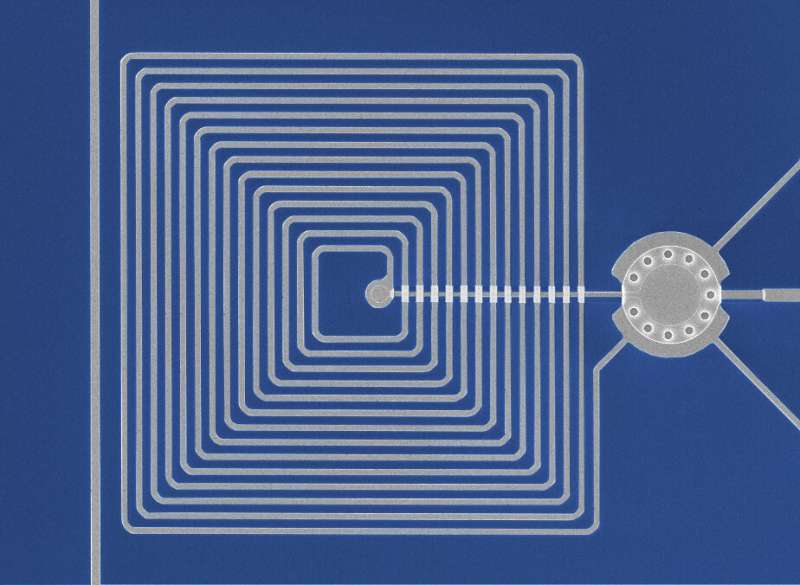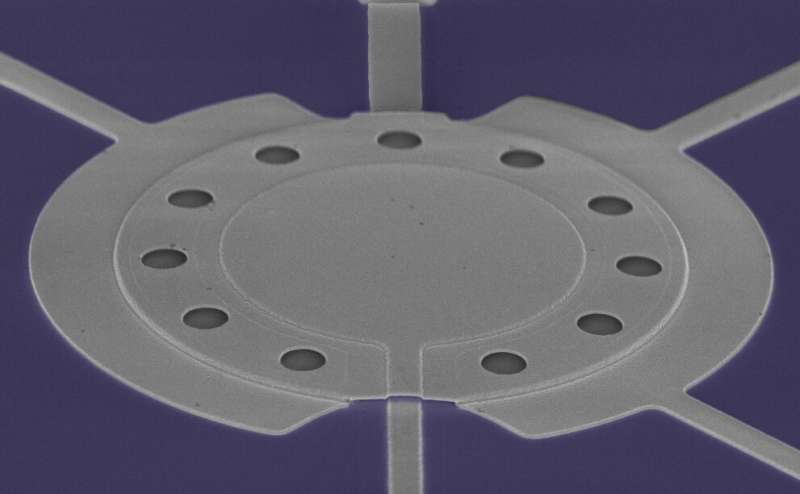November 20, 2019 feature
A technique to measure mechanical motion beyond the quantum limit

Researchers at the University of Colorado have recently developed a new technique to measure mechanical motion using simultaneous electromechanical amplification and cooling processes. Their method, presented in a paper published in Physical Review Letters, allowed them to perform a nearly noiseless measurement of the position of a mechanical oscillator, which has so far proved to be difficult using alternative techniques for measuring motion.
"Our research came about for two reasons," Robert Delaney, one of the researchers who carried out the study, told Phys.org. "First, we are using these mechanical systems to efficiently convert signals between the microwave domain and the optical domain. The conversion of signals between these two disparate frequency bands is important for networking future quantum computers, or to build the equivalent of the quantum internet."
Many research groups worldwide are currently trying to develop macroscopic mechanical oscillators in truly quantum states of motion, for both practical applications, such as force sensing, and tests of quantum mechanics at larger scales. In both these instances, characterizing and measuring the motion of the mechanical oscillators at the limits imposed by quantum mechanics will be of crucial importance.
In addition to enabling the conversion of signals between microwave and optical domains, Delaney and his colleagues wanted to figure out a way to measure this motion beyond the quantum limit. To achieve this, they modified a technique known as back-action evading measurement. Back-action evading measurement has been viewed as one of the most promising techniques for single quadrature measurement of motion for several years, yet it has so far achieved unsatisfactory results.
"Through the interaction of the mechanical oscillator with a microwave (or optical) cavity, back-action evading measurement in principle enables noiseless measurement of the position of the mechanical oscillator," Robert Delaney, one of the researchers who carried out the study, told Phys.org. "In practice, this has been difficult to implement because additional interactions between the microwave (or optical) field and the mechanical oscillator lead to instabilities in mechanical motion, which prevents continuous measurement."
To overcome the issues associated with these instabilities in mechanical motion, the researchers modified the conventional back-action evading scheme, in order to intentionally induce instability in a mechanical oscillator. This ultimately allowed them to collect a pulsed measurement of the oscillator's motion.
"By applying two microwave frequency pumps to the microwave resonator that are detuned by the resonant frequency of the mechanical oscillator we can enhance the interaction of the mechanical oscillator with the microwave field," Delaney explained. "One microwave tone is red-detuned, or below the resonant frequency of the microwave cavity, while the other tone is blue-detuned, or above the resonant frequency of the cavity."

The red detuned pump used by Delaney and his colleagues cools the mechanical oscillator via the microwave field in a way that resembles how laser cooling techniques cool atoms. The blue detuned pump, on the other hand, amplifies the mechanical oscillator's motion by continuously adding energy from the microwave field to the oscillator.
The blue detuned pump is larger than the red one. When combined in a way that amplifies on net, these two distinct processes interfere and amplify the position or the momentum (i.e., depending on the phase of the pumps) of the mechanical oscillator, with almost no noise. The two quadrature components that the researchers used to describe motion are simply dimensionless versions of the position and momentum of the mechanical oscillator.
"The main advantage of this technique is that it can measure a single quadrature of motion nearly noiselessly, and when characterizing fragile quantum states of motion, even a small amount of added noise can obscure the state of interest," Delaney said. "To fully characterize a quantum state of motion you need to perform quantum state tomography, and the ideal measurement for these state reconstruction techniques is a noiseless single quadrature measurement."
Mechanical oscillators are used in several physics subfields, for instance when conducting research investigating quantum mechanics on larger scales, quantum limited force sensing and quantum information. The technique developed by Delaney and his colleagues could thus have important implications for a variety of physics studies.
"In this work, we demonstrated a nearly noiseless measurement of the position of a mechanical oscillator, which has been difficult to achieve with previously used techniques like back-action evading measurement or external parametric amplification," Delaney said. "We also demonstrated that transient electromechanical amplification can be used to carefully characterize a quantum squeezed state, a prerequisite for using squeezing to enhance force sensing."
In the future, the method for measuring mechanical motion introduced by this team of researchers could open up new horizons for physics research and pave the way for the development of new tools, including force-sensing technology and techniques to link quantum computers. In addition, their method could be ideal for characterizing mechanical oscillators prepared in even more exotic quantum states, such as superposition states or cat states, a long-sought goal in the physics field.
"We're now focused on using electromechanical/optomechanical systems for microwave to optical conversion," Delaney said. "When integrated with other quantum computing components like superconducting qubits, we may use this technique to measure the motion of the mechanical oscillator in this system to verify that we generating quantum states."
More information: R. D. Delaney et al. Measurement of Motion beyond the Quantum Limit by Transient Amplification, Physical Review Letters (2019). DOI: 10.1103/PhysRevLett.123.183603
Journal information: Physical Review Letters
© 2019 Science X Network





















